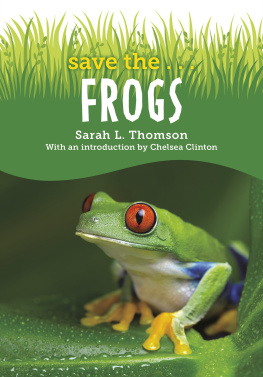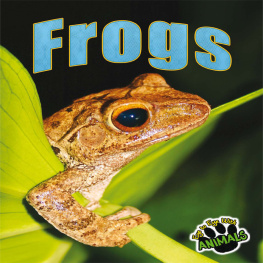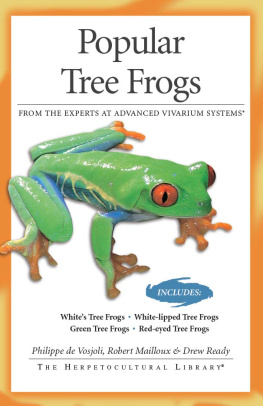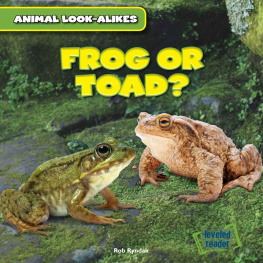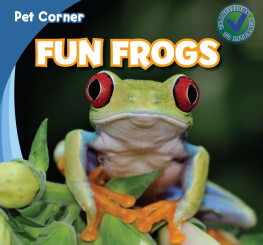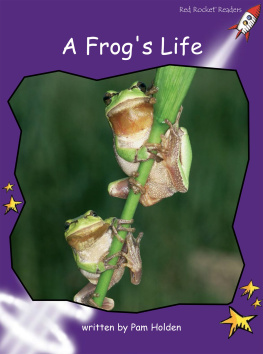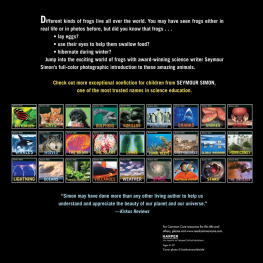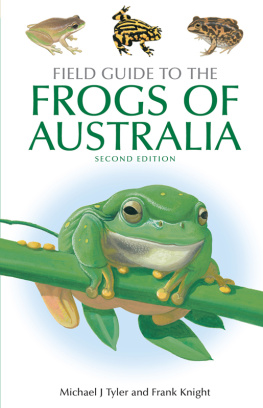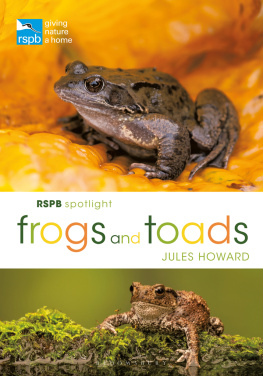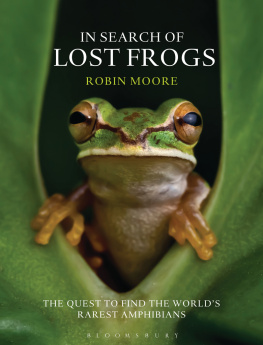Frogs: The Animal Answer Guide
Frogs
The Animal Answer Guide
Mike Dorcas and Whit Gibbons

2011 The Johns Hopkins University Press
All rights reserved. Published 2011
Printed in the United States of America on acid-free paper
9 8 7 6 5 4 3 2 1
The Johns Hopkins University Press
2715 North Charles Street
Baltimore, Maryland 21218-4363
www.press.jhu.edu
Library of Congress Cataloging-in-Publication Data
Dorcas, Michael E., 1963
Frogs: the animal answer guide / Mike Dorcas and Whit Gibbons.
p. cm.
Includes bibliographical references and index.
ISBN-13: 978-0-8018-9935-5 (hardcover : alk. paper)
ISBN-10: 0-8018-9935-4 (hardcover : alk. paper)
ISBN-13: 978-0-8018-9936-2 (pbk. : alk. paper)
ISBN-10: 0-8018-9936-2 (pbk. : alk. paper)
1. Frogs. I. Gibbons, J. Whitfield, 1939 II. Title.
QL668.E2D66 2011
597.89dc22 2010042484
A catalog record for this book is available from the British Library.
Special discounts are available for bulk purchases of this book. For more information, please contact Special Sales at 410-516-6936 or specialsales@press.jhu.edu.
The Johns Hopkins University Press uses environmentally friendly book materials, including recycled text paper that is composed of at least 30 percent post-consumer waste, whenever possible. All of our book papers are acid-free, and our jackets and covers are printed on paper with recycled content.
Be kind and tender to the Frog,
And do not call him names,
As Slimy skin, or Polly-wog,
Or likewise Ugly James,
Or Gap-a-grin, or Toad-gone-wrong,
Or Bill Bandy-knees:
The Frog is justly sensitive
To epithets like these.
No animal will more repay
A treatment kind and fair;
At least so lonely people say
Who keep a frog (and, by the way,
They are extremely rare).
HILAIRE BELLOC
Contents
Acknowledgments
We are grateful to the numerous staff and students at Davidson College and the Savannah River Ecology Laboratory for their encouragement and assistance in writing this book. In particular, we thank Margaret Wead for assisting in a variety of ways with the details of manuscript preparation. We thank Kimberly Andrews, Rick Bauer, Kurt Buhlmann, Adrien Domske, Evan Eskew, Shawna Foley, Alastair Freeman, Cris Hagen, Tom Luhring, David Millican, Tony Mills, Steve Price, Sean Poppy, David Scott, Charlotte Steelman, Brian Todd, Tracey Tuberville, J. D. Willson, and Lynea Witczak, all of whom were helpful in making suggestions and providing insights from their own experiences with frogs that improved this book. Lynea Witczak was particularly helpful by compiling the bibliography and assisting with the images. Patricia West of American University provided library assistance. Michael Gibbons, Cris Hagen, and J. D. Willson helped by tracking down or providing information we needed for the book.
We especially thank several frog specialists for their willingness to provide comments on particular questions, although we assume full responsibility for the final answers. The following provided comments that substantially improved the manuscript: Michael Gibbons, Cris Hagen, Tony Mills, and J. D. Willson. Joe Mendelson of Zoo Atlanta was particularly gracious to answer our repeated queries about his research. We appreciate the help of numerous photographers who generously provided images for us to use in the book. These photographers include Graham Alexander, Jonathan Campbell, Dante Fenolio, Mike Gibbons, Chris Gillette, Cris Hagen, Aubrey Heupel, Pierson Hill, H. B. Hines DERM, Vic Hutchison, Trip Lamb, Victor Lamoureux, Thomas Luhring, John Mackway, Shannon Pittman, Zbynek Rocek, Leslie Ruyle, Charlotte Steelman, Clyde Sorenson, Wayne Van Devender, John D. Willson, and Robert T. Zappalorti. We thank Susan Harris for compiling the index and assistance with proofing. Finally, we thank our families for their support, assistance, and understanding while we worked on this book. MD thanks his wife Tammy, and his children Taylor, Jessika, and Zachary. JWG thanks his wife Carol, and his children Laura, Jennifer, Susan, and Michael.
Introduction
Both of us grew up as herpetologists. We may not have realized it until later, but when we were young, we somehow acquired (or were born with?) a fascination for wildlife and, in particular, amphibians and reptiles. Such a fascination, one that requires exploration and further understanding, is a prerequisite for being a herpetologist. Thus, neither of us can pinpoint a moment in our lives when we became herpetologists. Instead, it is as if we always were. Most herpetologists have similar stories; that is, they grew up that way and have somehow been able to take their fascination and excitement while learning about frogs, turtles, and snakes and turn it into their lifes work and a career. Such fascination and interest by most herpetologists results in a remarkable dedication or, some might say, obsession regarding their work. We must be careful not to forget how fortunate we are to be able to make a living doing what we are most passionate about.
Like many herpetologists, we both were initially interested in snakes, but our interest in other groups of amphibians and reptiles increased dramatically as we learned more about their biology. One of our passions was frogs and toads, and each of us has had exciting and memorable experiences looking for frogs at night during large breeding choruses. As we became more experienced herpetologists, we learned about the fascinating life history variation among frogs and toads. Regarding reproduction, frogs nearly do it all. That is, think of any conceivable way to reproduce and a frog somewhere has figured it out beforehand. Both of us have conducted considerable research on frog biology and conservation and have had the opportunity to work with colleagues who are experts in the field. JWG has conducted several long-term studies on frogs and has studied them with numerous colleagues on the Savannah River Site in South Carolina for more than 40 years. MD began research on frogs in the early 1990s in Idaho and has worked collaboratively with students on many frog-related research projects in the years that followed.
The alarming and catastrophic declines in frog populations worldwide have led to a dramatic increase in the number of people interested in frogs and in the amount of research conducted on frogs. Clearly, we cannot adequately discuss all of this research in such a book. Instead, our goal is to answer questions posed in a way that allows the reader to gain insight into frogs and toads and to provide the reader with information that will raise their awareness regarding the importance of frogs and toads as part of our natural world.
Frogs: The Animal Answer Guide
Chapter 1
Introducing Frogs
What are frogs?
Frogs are members of the class Amphibia, often called amphibians, which includes all frogs and toads in addition to two other less-familiar groups of animals. Frogs and toads are vertebratesanimals with backboneswhich are generally recognizable and not easily confused with other animals. People rarely, if ever, say, Is that a frog? Instead, they are interested in identifying specific frogs or toads. Frogs and toads differ from two other groups of amphibians, salamanders and caecilians, because they lack a tail as an adult. Thus, they are placed in the order Anura, which means no tail. Scientists often refer to frogs and toads, collectively, as
Next page

